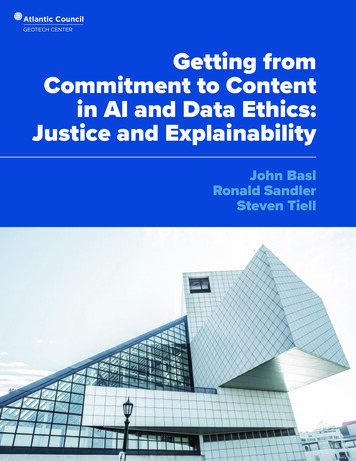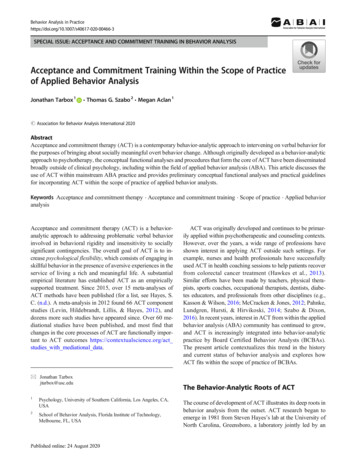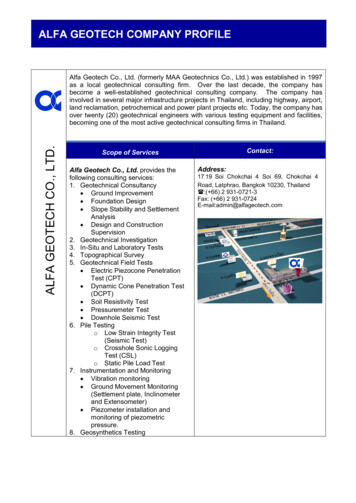
Transcription
GETTING FROM COMMITMENT TO CONTENT IN AI AND DATA ETHICSAtlantic CouncilGEOTECH CENTERGetting fromCommitment to Contentin AI and Data Ethics:Justice and ExplainabilityJohn BaslRonald SandlerSteven Tiell1
GETTING FROM COMMITMENT TO CONTENT IN AI AND DATA ETHICSAtlantic CouncilGEOTECH CENTERCover: Lance Anderson/UnsplashThis work is licensed under the Creative Commons Attribution 4.0 International License.To view a copy of this license, visit http://creativecommons.org/licenses/by/4.0/ or senda letter to Creative Commons, PO Box 1866, Mountain View, CA 94042, USA.This report is written and published in accordance with the AtlanticCouncil Policy on Intellectual Independence. The author is solelyresponsible for its analysis and recommendations. The AtlanticCouncil and its donors do not determine, nor do they necessarilyendorse or advocate for, any of this report’s conclusions.Atlantic Council1030 15th Street NW, 12th FloorWashington, DC 20005For more information, please visitwww.AtlanticCouncil.org.ISBN: 978-1-61977-189-5August 2021This report was designed by Donald Partyka and Liam Brophy2
GETTING FROM COMMITMENT TO CONTENT IN AI AND DATA ETHICSGetting from Commitment toContent in AI and Data Ethics:Justice and ExplainabilityJohn BaslRonald SandlerSteven Tiell3
GETTING FROM COMMITMENT TO CONTENT IN AI AND DATA ETHICSTABLE OF CONTENTS3I.6II. Example: Informed Consent in Bioethics8IntroductionIII. What Is Justice in Artificial Intelligenceand Machine Learning?9 1. The Values and Forms of Justice10 2. Justice in Artificial Intelligence and Data Systems13IV. What Is Transparency in ArtificialIntelligence and Machine Learning?13141. The Values and Concepts Underlying Transparency2. Specifying Transparency Commitments17V. Conclusion: From Normative Content toSpecific Commitments19VI. Contributors1
GETTING FROM COMMITMENT TO CONTENT IN AI AND DATA ETHICSEXECUTIVE SUMMARY:There is widespread awareness among researchers, companies, policy makers, and the public that the use of artificial intelligence (AI) and big data raises challenges involvingjustice, privacy, autonomy, transparency, and accountability.Organizations are increasingly expected to address theseand other ethical issues. In response, many companies, nongovernmental organizations, and governmental entities haveadopted AI or data ethics frameworks and principles meantto demonstrate a commitment to addressing the challengesposed by AI and, crucially, guide organizational efforts todevelop and implement AI in socially and ethically responsible ways.of AI and big data will continue, and industry will be seen bypolicy makers, employees, consumers, clients, and the publicas failing to make good on its own stated commitments.The next step in moving from general principles to impactsis to clearly and concretely articulate what justice, privacy,autonomy, transparency, and explainability actually involveand require in particular contexts. The primary objectives ofthis report are to: demonstrate the importance and complexity of mov-ing from general ethical concepts and principles toaction-guiding substantive content;However, articulating values, ethical concepts, and generalprinciples is only the first step—and in many ways the easiestone—in addressing AI and data ethics challenges. The harderwork is moving from values, concepts, and principles to substantive, practical commitments that are action-guiding andmeasurable. Without this, adoption of broad commitmentsand principles amounts to little more than platitudes and “ethics washing.” The ethically problematic development and use provide detailed discussion of two centrally important andinterconnected ethical concepts, justice and transparency;and indicate strategies for moving from general ethical con-cepts and principles to more specific substantive contentand ultimately to operationalizing those concepts.2
GETTING FROM COMMITMENT TO CONTENT IN AI AND DATA ETHICSI. INTRODUCTIONThere is widespread awareness among researchers, companies, policy makers, and the public that the use of artificial intelligence (AI) andbig data analytics often raises ethical challengesinvolving such things as justice, fairness, privacy, autonomy, transparency, and accountability. Organizations areincreasingly expected to address these issues. However,they are asked to do so in the absence of robust regulatory guidance. Furthermore, social and ethical expectations exceed legal standards, and they will continue to doso because the rate of technological innovation and adoption outpaces that of regulatory and policy processes.In response, many organizations—private companies, nongovernmental organizations, and governmental entities—have adopted AI or data ethics frameworks and principles.They are meant to demonstrate a commitment to addressingthe ethical challenges posed by AI and, crucially, guide organizational efforts to develop and implement AI in socially andethically responsible ways.Table 1: Examples of Principles, Codes, and Value StatementsAs the ethical issues associated with AI and big data have become manifest, organizations have developed principles, codes, andvalue statements that (1) signal their commitment to socially responsible AI; (2) reflect their understanding of the ethical challengesposed by AI; (3) articulate their understanding of what socially responsible AI involves; and (4) provide guidance for organizationalefforts to accomplish that vision.Identifying a set of ethical concepts, and formulating general principles using those concepts, is a crucial componentof articulating AI and data ethics. Moreover, there is considerable convergence among the many frameworks that havebeen developed. They coalesce around core concepts, someof which are individual oriented, some of which are societyoriented, and some of which are system oriented (see Table2). That there is a general overlapping consensus on the primary ethical concepts indicates that progress has been madein understanding what responsible development and use ofAI and big data involves.3
GETTING FROM COMMITMENT TO CONTENT IN AI AND DATA ETHICSTable 2: Normative ConceptsAI and data ethics statements and codes have coalesced around several ethical concepts. Some of these concepts are focused onthe interests and rights of impacted individuals, e.g., protecting privacy, promoting autonomy, and ensuring accessibility. Others arefocused on societal-level considerations, e.g., promoting justice, maintaining democratic institutions, and fostering the social good.Still others are focused on features of the technical systems, e.g., that how they work is sufficiently transparent or interpretable so thatdecisions can be explained and there is accountability for them.However, articulating values, ethical concepts, and generalprinciples is only the first step in addressing AI and data ethicschallenges—and it is in many ways the easiest. It is relativelylow cost and low commitment to develop and adopt thesestatements as aspirational documents.these in practice2 (see Figure 1 for what these tasks encompass and how they are interconnected). Accomplishing theseinvolves longitudinal effort and resources, as well as collaborative multidisciplinary expertise. New priorities and initiativesmight be required, and existing organizational processes andstructures might need to be revised. But these are the crucial steps in realizing the espoused values and commitments.Without them, any commitments or principles become mere“ethics washing.” Ethically problematic development and useof AI and big data will continue and industry will be seen bypolicy makers, employees, consumers, and the public as failing to make good on its own stated commitments.The much harder work is the following: (1) substantively specifying the content of the concepts, principles, and commitments—that is, clarifying what justice, privacy, autonomy,transparency, and explainability actually involve and requirein particular contexts;1 and (2) building professional, social,and organizational capacity to operationalize and realize12Kate Crawford et al., AI Now 2019 Report, AI Now Institute, December 2019, https://ainowinstitute.org/AI Now 2019 Report.html, 20.Ronald Sandler and John Basl, Building Data and AI Ethics Committees, Accenture, August 2019,https://www.accenture.com/ ittee-Report-11.pdf.4
GETTING FROM COMMITMENT TO CONTENT IN AI AND DATA ETHICSFigure 1: Moving from Values to Actionable Commitments and Standards of EvaluationThe objectives of this report are to:Defining “Normative Content” demonstrate the importance and complexity of mov-ing from general ethical concepts and principles toaction-guiding substantive content, hereafter called normative content;There are two uses of the term “norms.” One is descriptive, for which“norms” describe what is ordinary or typical to do. The other is ethical, for which “norms” prescribe what ought or should be done.Often, what ought or should be done (prescriptive) is different fromwhat is currently being done (descriptive). The call for ethics for, andresponsible development and use more generally of, AI and big datais a call for guidance on how it ought to be done because currentpractices are problematic in many respects. For example, justice-oriented considerations ought to be incorporated in ways that avoidperpetuating discriminatory practices and unjustified inequalities. provide detailed analysis of two widely discussed andinterconnected ethical concepts, justice and transparency; and indicate strategies for moving from general ethical concepts and principles to more specific normative contentand ultimately to operationalizing that content.Therefore, as the term is used here, normative content refers to guidance on what “ought” or “should” be done. It is about developingwell-justified standards, principles, and practices for what individuals,groups, and organizations should do, rather than merely describingwhat they currently do.Normative content (in the ethical, prescriptive sense) is ultimatelygrounded on values, both social and organizational. This report isabout the process of translating those general values into concreteand actionable guidance and commitments. This process is complexbecause specific principles and commitments need to be contextsensitive, and because different values can sometimes come intotension with each other.5
GETTING FROM COMMITMENT TO CONTENT IN AI AND DATA ETHICSII. EXAMPLE: INFORMED CONSENT IN BIOETHICS3To illustrate the challenge of moving from a general ethical concept to action-guiding normative content it is helpful to reflecton an established case, such as informed consent in bioethics.Informed consent is widely recognized as a crucial componentto ethical clinical practice and research in medicine. But wheredoes the principle come from? What, exactly, does it mean? Andwhat does accomplishing it involve?3form that they can understand. The voluntariness condition is thatthey make the decision without undue influence or coercion.But these three conditions must themselves be operationalized, which is the work of institutional review boards, hospital ethics committees, professional organizations, and bioethicists. They develop best practices, standards, and proceduresfor meeting the informed consent conditions—e.g., what information needs to be provided to potential research subjects,what level of understanding constitutes comprehension forpatients, and how physicians can provide professional opinions without undue influence on decisions. Moreover, standards and best practices can and must be contextually sensitive. They cannot be the same in emergency medicine asthey are in clinical practice, for example. It has been decadessince the principle of informed consent was adopted in medicine and research, yet it remains under continuous refinementin response to new issues, concerns, and contexts to ensurethat it protects individual autonomy.Informed consent is taken to be a requirement of ethicalpractice in medicine and human subjects research becauseit protects individual autonomy.4 Respecting people’s autonomy means not manipulating them, deceiving them, or beingoverly paternalistic toward them. People have rights overthemselves, and this includes choosing whether to participatein a research trial or undergo medical treatment. A requirement of informed consent is the dominant way of operationalizing respect for autonomy.But what is required to satisfy the norm of informed consentin practice? When informed consent is explicated, it is takento have three main conditions: disclosure, comprehension,and voluntariness. The disclosure condition is that patients,research subjects, or their proxies are provided clear, accurate, and relevant information about the situation and the decision they are being asked to make. The comprehension condition is that the information is presented to them in a way orSo while informed consent is meant to protect the value ofautonomy and express respect for persons, a general commitment to the principle of informed consent is just the beginning. The principle must be explicated and operationalizedbefore it is meaningful and useful in practice. The same is truefor principles of AI and data ethics.5Figure 2. Example: Respect for persons in medical research (via IRB)In clinical medicine and medical research, a foundational value is respect for the people involved—the patients andresearch subjects. But to know what that value requires in practice it must be clarified and operationalized. In medicine,respect for persons is understood in terms of autonomy of choice, which requires informed consent on the part of thepatient or subject. Bioethicists, clinicians, and researchers have operationalized autonomous informed consent in terms ofcertain choice conditions: disclosure, comprehension, and voluntariness. These are then realized through a host of specificpractices, such as disclosing information in a patient's primary language, maintaining context of consent for research subjects, and not obscuring information about risks. Thus, respect for persons is realized in medical contexts when these conditions are met through the specified practices for the context. It is therefore crucial to the ethics of medicine and medicalresearch that these be implemented in practice in context-specific ways.34This section is adapted from Ronald Sandler and John Basl, Building Data and AI Ethics Committees, Accenture, August 2019,https://www.accenture.com/ ittee-Report-11.pdf, 13.National Commission for the Protection of Human Subjects of Biomedical and Behavioral Research, The Belmont Report: Ethical Principles and Guidelines for the Protection of Human Subjects of Research, April 18, 1979, elmont-report-508c FINAL.pdf.6
GETTING FROM COMMITMENT TO CONTENT IN AI AND DATA ETHICS What a general principle requires in practice can differ sig-The case of informed consent in bioethics has several lessonsfor understanding the challenge of moving from general ethical concepts to practical guidance in AI and data ethics:nificantly by context. It will often take collaborative expertise—technical, ethical,and context specific—to operationalize a general ethicalconcept or principle. Because novel, unexpected, contextual, and confounding considerations often arise, there need to be ongoingefforts, supported by organizational structures and practices, to monitor, assess, and improve operationalization ofthe principles and implementation in practice. It is not possible to operationalize them once and then move on. To get from a general ethical concept (e.g., justice, expla-nation, privacy) to practical guidance, it is first necessaryto specify the normative content (i.e., specify the generalprinciple and provide context-specific operationalizationof it). Specifying the normative content often involves clarifyingthe foundational values it is meant to protect or promote.Figure 3. The Process of Specifying Normative ContentAI and data ethics encompass the following: clarifying foundational values and core ethical concepts, specifying normative content(general principles and context-specific operationalization of them), and implementation in practice.In what follows, the focus is on the complexities involved inmoving from core concepts and principles to operationalization—the normative content—for two prominently discussedand interconnected AI and data ethics concepts: justice andtransparency.7
GETTING FROM COMMITMENT TO CONTENT IN AI AND DATA ETHICSIII. WHAT IS JUSTICE IN ARTIFICIALINTELLIGENCE AND MACHINE LEARNING?There is consensus that justice is a crucial ethical consideration in AI and data ethics.5,6 Machine learning (ML), dataanalytics, and AI more generally should, at a minimum,not exacerbate existing injustices or introduce new ones.Moreover, there is potential for AI/ML to reduce injusticeby uncovering and correcting for (typically unintended)biases and unfairness in current decision-making systems.Problems of Fairness and Justice in AIand Data EthicsFairness and justice are widely recognized as key componentsof AI and data ethics. One reason for this is that there alreadyhave been many high-profile cases where machine learning andautomated decision systems have led to biased, discriminatory,or otherwise problematically unequal results. Here are just a fewexamples:The Meanings of “Fairness”and “Justice” AI recruiting and job advertising systems have been found to“Fairness” and “justice” are often used interchangeably in the discourse around AI and data ethics, andthat is how they are used here. The reason for this isto encompass the full range of considerations that fallunder them (as indicated below). However, the termsalso sometimes have more specific meanings. Forexample, among computer scientists who work onthese issues, “fairness” is often used to refer to certain forms of parity among groups. So, for example, analgorithmic system would be “fair” if it had the samelevel of accuracy or false positive rates across protected groups. A common question raised is which,if any, of those forms of parity is the appropriate operationalization of fairness for that context (since it isoften impossible to realize multiple forms of paritytogether). In institutional contexts, “fairness” is oftenused to refer to treatment in a particular context,whereas “justice” refers to the institutional featuresthat structure the context—a process (e.g., lending orcriminal justice) can be unfair because the system isunjust (e.g., organized in a way that advantages somegroups and disadvantages others).replicate existing racial and gender biases and stereotypes inthe workforce1 AI systems used to assign risk scores in medical contextsassigned lower risk scores to African-American patients ascompared to white patients, resulting in their receiving lesscare or less urgent care2 Facial recognition systems have been found to be raciallybiased3 AI systems used in social service eligibility determinations aremaking it more difficult for people to access benefits for whichthey are qualified4 Hate speech detection systems have been found to wronglyclassify speech patterns associated with African-Americans ashate speech5 A recidivism prediction system used in parole and bail settingoverpredicted recidivism by African-Americans and underpredicted recidivism by whites6 AI advertising systems have been found to racially differentiate with apartment listings71234567Miranda Bogen, “All the Ways Hiring Algorithms Can Introduce Bias,” Harvard Business Review, May 6, 2019, thms-can-introduce-bias.Ziad Obermeyer et al., “Dissecting Racial Bias in an Algorithm Usedto Manage the Health of Populations,” Science 366, no. 6464 (October 25, 2019): 447–53, https://doi.org/10.1126/science.aax2342.Sophie Bushwick, “How NIST Tested Facial Recognition Algorithms for RacialBias,” Scientific American, December 27, 2019, bias/.Ed Pilkington, “Digital Dystopia: How Algorithms Punish the Poor,” The Guardian, October 14, rlotte Jee, “Google’s Algorithm for Detecting Hate Speech Is RaciallyBiased,” MIT Technology Review, August 13, looks-racially-biased/.Julia Angwin Mattu, Jeff Larson, and Surya Lauren Kirchner, “Machine Bias,”ProPublica, May 23, as-risk-assessments-in-criminal-sentencing?token f3FajB9MLCTEMdgLRTeO6gSsoYw-yhCA.Louise Matsakis, “Facebook’s Ad System Might Be Hard-Coded for Discrimination,” Wired, April 6, 2019, scrimination/.However, the concept of “justice” is complex, and can referto different things in different contexts. To determine whatjustice in AI and data use requires in a particular context—for example, in deciding on loan applications, social serviceaccess, or healthcare prioritization—it is necessary to clarifythe normative content and underlying values. Only then is itpossible to specify what is required in specific cases, and inturn how (or to what extent) justice can be operationalizedin technical and techno-social systems.568Cyrus Rafar, “Bias in AI: A Problem Recognized but Still Unresolved,”TechCrunch, July 25, aproblem-recognized-but-still-unresolved/Reuben Binns et al., “‘It’s Reducing a Human Being to a Percentage’: Perceptions of Justice in Algorithmic Decisions,” inProceedings of the 2018 CHI Conference on Human Factorsin Computing Systems, CHI ’18, Association for Computing Machinery, 2018, https://doi.org/10.1145/3173574.3173951, 1–14.
GETTING FROM COMMITMENT TO CONTENT IN AI AND DATA ETHICSIII. 1: THE VALUES AND FORMS OF JUSTICEThe foundational value that underlies justice is the equalworth and political standing of people. The domain of justice concerns how to organize social, political, economic, andother systems and structures in accordance with these values.A law, institution, process, or algorithm is unjust when it fails toembody these values. So, the most general principle of justiceis that all people should be equally respected and valued insocial, economic, and political systems and processes.However, there are many ways these core values and thisvery general principle of justice intersect with social structuresand systems. As a result, there is a diverse set of more specific justice-oriented principles, examples of which are givenin Table 3.Table 3. Justice-Oriented PrinciplesEach of these principles concerns social, political, or economic systems and structures. Some of the principles addressthe processes by which systems work (procedural justice).Others address the outcomes of the system (distributive justice). Still others address how people are represented withinsystems (recognition justice). There are many ways for thingsto be unjust, and many ways to promote justice.discussions about K-12 education. Equality of participationis important in political contexts. Prioritizing the worst off isimportant in some social services contexts. Just deserts isimportant in innovation contexts. And so on. The questionto ask about these various justice-oriented principles whenthinking about AI or big data is not which of them is the corrector most important aspect of justice. The questions are the following: Which principles are appropriate in which contexts orsituations? And what do they call for or require in those contexts or situations?Each of these justice-oriented principles is important in specific situations. Equality of opportunity is often crucial in9
GETTING FROM COMMITMENT TO CONTENT IN AI AND DATA ETHICSIII. 2: JUSTICE IN ARTIFICIALINTELLIGENCE AND DATA SYSTEMSWhat is an organization committing to when it commits to justice in AI and data practices? Context is critically important indetermining which justice-oriented principles are operativeor take precedence. Therefore, the first step in specifying themeaning of a commitment—i.e., specifying the normative content—is to identify the justice-oriented principles that are crucial to the work that the AI or data system does or the contextsin which they operate. Only then can a commitment to justicebe effectively operationalized and put into practice.in which they operate. In identifying these, it will often be helpful to reflect on similar cases and carefully consider the sorts ofconcerns that people have raised about AI, big data, and automated decision-making. Consider again some of the problemcases discussed earlier (see Problems of Fairness and Justicein AI and Data Ethics). Several of them, such as the sentencing and employment cases, raise issues related to equality ofopportunity and equal treatment. Others, such as those concerning facial and speech recognition, involve representationand access. Still others, such as the healthcare cases, involveaccess and treatment as well as prioritization, restitutive, andbenefit considerations. Here are two hypothetical and simplified cases—a private financial services company and a publicsocial service organization—to illustrate this. They share thesame foundational values (equal worth and political standing of people) and core ethical concepts (fairness and justice).However, they diverge in how these are specified, operationalized, and implemented due to what the algorithmic systemdoes, its institutional context, and relevant social factors (seeFigure 4 and Figure 5).Legal compliance will of course be relevant to identifying salient justice-oriented considerations—for example,statutes on nondiscrimination. But, as discussed above,legal compliance alone is insufficient.7 Articulating the relevant justice-oriented principles will also require considering organizational missions, the types of products and services involved, how those products and services couldimpact communities and individuals, and organizationalunderstanding of the causes of injustice within the spaceFigure 4. Example: Private Financial Services CompanyFinancial services firms trying to achieve justice and fairness must, at a minimum, be committed to nondiscrimination, equaltreatment, and equal access. These cannot be accomplished if there is differential consideration, treatment, or access basedon characteristics irrelevant to an individual’s suitability for the service. To prevent this, a financial services firm might encourageapplications from diverse communities, require explanations to applicants who are denied services, and participate in regularauditing and reporting processes, for example. Implementing these and other measures would promote justice and fairness inpractice. To be clear, these may not be exhaustive of what justice requires for financial services firms. For instance, if there hasbeen a prior history of unfair or discriminatory practices toward particular groups, then reparative justice might be a relevantjustice-oriented principle as well. Or if a firm has a social mission to promote equality or social mobility, then benefiting the worstoff might also be a relevant justice-oriented principle.7Solon Barocas and Andrew D. Selbst, “Big Data’s Disparate Impact,” California Law Review 104 (2016): 671,https://heinonline.org/HOL/LandingPage?handle hein.journals/calr104&div 25&id &page .10
GETTING FROM COMMITMENT TO CONTENT IN AI AND DATA ETHICSFigure 5. Example: Public Social Service OrganizationSocial service organizations are publicly accountable and typically have well-defined social missions and responsibilities. These are relevant to determining which principles of justice are most salient for their work. It is often part of theirmission that they provide benefits to certain groups. Because of this, justice and fairness for a social service organization may require not only nondiscrimination, but also ensuring access and benefitting the worst off. This is embodied inprinciples such as no differential consideration or treatment based on irrelevant characteristics, presumption of eligibility (i.e., access is a right rather than a privilege), and maximizing accessibility of services. Operationalizing these couldinvolve requiring explanations for service denial decisions and having an available appeals/recourse process, creatingprovisions for routine auditing, providing assistance to help potential clients access benefits, conducting outreach tothose who may be eligible for services, and integrating with other services that might benefit clients.When there are multiple justice-oriented considerations thatare relevant, it can frequently be necessary to balance them.For example, prioritizing the worst off or those who havebeen historically disadvantaged can sometimes involvemoving away from same treatment. Or accomplishing equalopportunity and access can sometimes require compromises on just deserts. What is crucial is that all the relevantjustice-oriented principles for the situation are identified;that the process of identification is inclusive of the communities most impacted; that all operative principles are considered as far as possible; and that any compromises are justified by the contextual importance of other justice-orientedconsiderations.Recidivism Predication and theImportance of Clarifying theAppropriate Conception of JusticeIn the much-discussed case of the COMPAS recidivismprediction algorithm, there was a trade-off betweenequal accuracy among groups on the one handand equal false positive and negative rates amonggroups on the other hand. The prediction system
responsible development and use more generally of, AI and big data is a call for guidance on how it ought to be done because current practices are problematic in many respects. For example, justice-ori - ented considerations ought to be incorporated in ways that avoid perpetuating discriminatory practices and unjustified inequalities.










